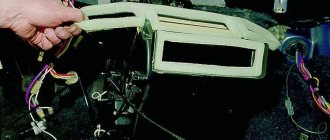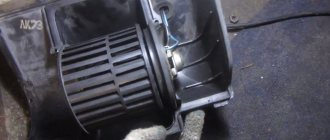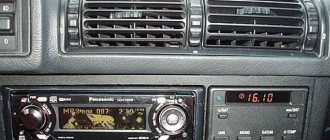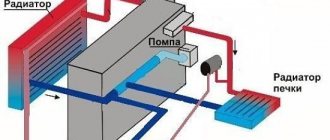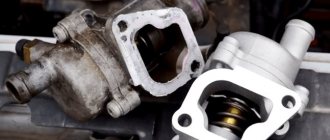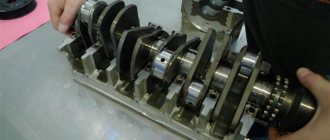11.05.2019
| (No votes) |
Issues discussed in the material:
- How does a car heating system work?
- What are the problems with the stove?
- How problems in the cooling system affect the temperature in the car
- When and how to service the cooling and heating system
- How to properly maintain the stove in your car
- How to start a car correctly in winter
Every car in our country goes through a difficult period of winter operation. Due to low temperatures, your car may not start; emergency situations occur during icy conditions and snowstorms. It also happens that the stove in the car does not heat up, and being in your own car ceases to be comfortable, because you are freezing. Why does the car heating stop working properly? How to deal with such a breakdown? You will learn about this later in the article.
How does the stove work in a car?
Before you begin to identify the reason why, when the car is stopped, the stove refuses to heat, we recommend that you understand how heating works. After all, knowing the basics of its functioning, you can easily find a breakdown.
Both the small sedan and the truck are made of metal. Therefore, the body is strongly affected by temperature changes:
- In hot weather, the car warms up to a temperature of 40–50 degrees Celsius. In winter, it will be only a couple of degrees warmer in the car than outside. To move your car comfortably during the summer months, we use an air conditioning system.
- During the cold season, you can maintain optimal temperatures in your car using a heating system. Moreover, in our country you have to use the stove most of the year, so it must provide heat.
Previously, the car was warmed up using a stove-stove, as well as gas lamps. And only in 1917, they began to install an autonomous heating system on cars produced in America: the car began to heat up due to the heat from the exhaust pipe. For example, this heating method was used in the 1929 Ford Model A. In addition, cars began to warm up with an installed radiator, which was blown by a fan. This heating system was used on General Motors models. Over the years, every car began to be heated using such a system.
Each modern car is equipped with a heating unit, which is made of such components as:
- fan motor;
- air duct system;
- inlet and outlet pipes;
- stove heat exchanger;
- faucet that regulates the supply of coolant;
- heating equipment control unit;
- dampers, the drive of which can be mechanical or electric.
Usually the car is equipped with a stove, which is located behind the front panel. 2 tubes extend from it, supplying coolant to the radiator. It moves thanks to a pump (pump) both through the engine cooling system and through the heating system.
Heat exchange is possible due to the heating of the motor. Its cooling occurs due to antifreeze: it takes away thermal energy. The heated antifreeze enters the radiator of the stove, which heats according to the same principle as a standard battery in your home. At the same time, the stove fan starts working. It ensures the movement of cold air through the radiator. Here again there is an exchange of heat: the air is heated by the radiator, cooling it at the same time.
The heated air flow is directed into the cabin, and the cooled antifreeze enters the engine, where the heating process begins again. This heating system is used in most cars because its efficiency is quite high. In winter, the car will warm up provided that air with a temperature of 30 degrees Celsius is blown from the stove. This not only ensures that the interior is warmed up, but the windows also remain fog-free. A blower mode switch is installed on the dashboard. With its help, you can change the location of the dampers that regulate the air flow. It can be directed straight, down, up.
Almost all the time, warm air should be directed upward - that is, onto the windshield. This is the only way to maintain an optimal level of pressure in the cabin, when condensation does not form on the glass, and dust microparticles do not penetrate inside the car.
The stove plays the role of another radiator. Therefore, when the car is cold and you turn on the heat, the entire system begins to cool down. As a result, the walls of the radiator rust, the engine, like the car, takes longer to warm up. Air humidity rises, windows fog up from the inside. This means that the stove can only be turned on if the coolant temperature has risen to at least 50 degrees Celsius.
We recommend
“How they deceive you at a car service center and what you can do to protect yourself” Read more
Operating the stove in a car
Most often, no problems arise when repairing the stove in a car when it does not heat. Standard manipulations that will help solve the problem are disassembling and cleaning the heating system elements from dust and dirt.
But in some cases serious breakdowns occur.
Why, even if the car is working properly, the stove in it does not heat well? The reasons may be the following: the radiator or faucet is clogged, the pump is broken.
When the pump is faulty, it drives the engine cylinder head, causing the engine to overheat. Unfortunately, only a major engine overhaul will help here.
When the incoming hose of the heater radiator is hot, while the outlet hose is cold, most likely the faucet has broken down. Is this failure ruled out? Then you will have to replace the heater radiator. During operation, scale accumulates in it, which can be quite large.
It also happens that an air lock forms in the stove. The reason for this is that the tubes are not wide enough so the fluid flow cannot eliminate it. How to remove a traffic jam? We wait until the car and engine warm up well, loosen the clamp on the hose, and remove it from the tube. At this moment, a small gap is formed through which excess air will escape.
The car has stopped warming up, but the interior smells bad? Most likely, the radiator became dirty and stopped heating, and rotting began inside it.
The machine has components that need to be regularly inspected and repaired, and the stove is no exception. Therefore, the older the car, the worse the radiator will heat and the more seriously you need to approach its preparation for the cold season.
How to determine that the car is not warming up? Focus on generally accepted indicators. So, if the outside temperature drops to -25 °C, then at the bottom of the cabin it should be at least +16 °C and +10 °C at the ceiling. Otherwise, it is considered that the radiator in the car does not heat.
Do not forget that the older your car, the more carefully you need to monitor the serviceability of the stove.
Let's look at the reasons why the stove in the car does not heat well or why unheated air enters the cabin.
Warm-cold regulator drive
This system mechanism can cause the heater to blow cold air. The reason lies in the control drive device itself. Basically, all control devices of this type are equipped with metal cables.
At a certain point, the switch may get stuck in one position. At that moment, if the regulator is stuck in the “warm” position, then warm air will begin to flow into the cabin. Its temperature will depend on the degree of opening of the damper at the moment of jamming. But if the damper control is stuck in the closed position, the stove blows cold air.
Regardless of what the controls and controls for the heater dampers and taps look like (lever, wheel, dial switch), the malfunction is the same. Often there is a break in the traction elements (cable, rod) from the fastenings on the valves and control levers. Less often, the cables become clogged and rust in the protective case and do not move well in it.
At a time when the stove is blowing cold air due to a malfunction of the control drives, and it is not possible to carry out a full repair (for example, on the road), you need to manually move the shut-off valves to the “open” position. In cars in which the temperature control is driven by electronic mechanisms, first of all you need to check the condition of the system fuses. But generally it is recommended to contact the nearest car service center.
What to do if the stove adjustment does not work
Another problem is the malfunction of the switch. The control mechanism itself includes several elements. These are regulators of temperature, operating modes, distribution of air masses, and the lever that switches the damper is also turned on.
If the stove adjustment does not work, it is necessary to study the main reasons for the development of problems.
Possible reasons:
- The shift control cable is faulty. Then it moves normally only in one direction, not reaching the other side.
- Abrupt switching on or off leads to mechanical failure. The switch needs to be replaced.
- Problems associated with the thermistor appear in the form of one operating mode. For example, the heater can only operate at speed 4. This will require installing a new element.
- A breakdown of the temperature sensor disrupts the operation of the system. Replacement is required to eliminate the defect.
- Problems with wiring - a violation of the integrity of the connection affects the operation of the regulation system. Repair involves restoring the wire.
How to repair the mode switch and replace faulty parts:
- work begins with disconnecting the negative terminal, removing the assembly and disassembling;
- it is necessary to remove the radio and turn off the power;
- further, the damper switch lever, temperature regulator, and flow distribution are dismantled;
- by removing the plugs at the bottom, you can easily unscrew the screws, which will make it possible to dismantle the console;
- The power connectors are easy to find in the back; you need to unplug them.
After performing such manipulations, you can begin to eliminate the defect, depending on the detected breakdown.
Assembly is performed in reverse order.
Separately, it is worth highlighting situations when the second position of the stove does not work. If only one speed does not function, the problem lies in the resistor, its contacts, springs, and wires. The part is located under the panel in the gas pedal area on the right side.
What to do to fix the problem - you need to replace the device or check the wires, which sometimes fall off or burn out.
Why the stove in the car doesn’t heat up, and how to fix it
The radiator is the main element of your car's heater. The purpose of the radiator is to warm the air flow coming from outside before it enters the cabin. Therefore, if the stove begins to heat poorly and the car is cold, the first thing to do is check the radiator.
1. The coolant does not pass through the radiator.
If you added water, antifreeze, or another brand of coolant to the antifreeze, then a clogged solid sediment will appear in the radiator channels, which will prevent it from heating.
The same thing will happen if you add all sorts of cleaning additives to the antifreeze that your friends recommend to you or that you learned about on Youtube.
If deposits and scale form in the radiator, the honeycombs will become clogged and the movement of antifreeze will be disrupted. What to do if the car is cold because the heater has stopped heating:
- We buy another, possibly a used radiator. When choosing from several contract spare parts, give preference to the lightweight model;
- flush the radiator. You can do this on your own. You will need 50 g of citric acid, which should be diluted in 1 liter of heated water. We unscrew the hoses from the heating system and screw them tightly to two plastic bottles. Moreover, we release the air from the first bottle in advance, and pour the resulting liquid into the second. We squeeze one or the other bottle so that the solution circulates through the hoses, cleaning the radiator;
- swap the pipes. This way, the antifreeze will begin to move in the other direction, and the accumulated scale will be cleared, making the inside of your car warmer.
Removing and replacing a radiator is not an easy process, no matter what kind of car you have. We recommend that you first clean the radiator, and then it will start heating. However, this procedure only helps in 50% of problem situations. In addition, removing solid deposits can lead to leaks.
Have you done the flushing, but the heat in your car is still weak? Then we proceed to clean the entire cooling system and fill in new coolant.
When the car is idling and the heater is not heating up, the cause is almost always a worn-out radiator. This situation can be prevented only by timely prevention. We'll talk further about how to do this.
2. The radiator heats up, but the stove does not heat up.
The culprit is a breakdown of the electric motor that rotates the fan. How to fix the problem? We install a new electric motor.
3. Malfunctions of the stove controls or electronics.
Don't forget about the power buttons, temperature mode selection levers, as well as the electronic relay.
For example, the air damper may not work because there is a breakdown in the climate control unit or temperature sensor. In such a situation, the signal is not sent to the drive, which cannot open the damper, which means that not heated, but cooled air is supplied to the cabin.
Damage may occur if the temperature switch is set to the selected position while the battery terminal has been removed.
When the stove in the car does not heat for these reasons, you can fix the problem as follows:
- buy and install new heating elements to replace broken ones;
- manually move the valve valves to the open position;
- set the temperature lever to maximum, unplug the terminal. Then set the lever to the minimum temperature and check that the temperature is regulated normally.
This manipulation did not fix the problem and the car is cold? This means the problem is much more serious. To find out the reason why the stove in the car does not heat, you will have to go to a car service center, where a professional will disassemble the heating system and diagnose it.
We recommend
“Checking engine compression: why is it so important?
» More details 4. Cabin filter dirty.
The stove in your car may stop heating because the filter is dirty. To fix the problem, you will have to install a new filter.
If there is no filter (and this also happens), remove accumulated dirt from the air duct. If possible, reach the heater radiator and blow it out with compressed air.
5. Problems with the fan.
The reason that the car does not warm up may not only be the stove. Thus, the radiator may be poorly ventilated, as a result of which thermal energy is not removed from it due to the fact that the fan is faulty.
What can be done in this case? When the fan is completely broken, the situation is very clear. But what if it rotates, albeit slowly? Most often, the reason for this is worn out motor brushes or jammed bearings. To fix such breakdowns, in any case, you will need to contact an experienced auto electrician.
6. Damper servo drive is damaged.
Why does the car heat up, but the heater doesn’t heat up and it’s still cold in the cabin? The reason is a malfunction of the damper. In new cars, the radiator of the heating system always heats up; warm air from it enters the cabin if the air duct damper is open. But when it is not fully open or does not open at all, the interior will not be able to warm up.
The servo drive moves the damper; it can be controlled using a knob or buttons on the climate control panel. A breakdown can occur directly in the servo drive or in the cables and rods responsible for the movement of the damper: they can slip off.
How to fix the problem in this case? It will be possible to find out the reason after the heating system panel is disassembled. Did you see that the cables or rods have come off? Install them back.
It can only be determined at a specialized car service center that the servo drive is broken. Basically, servos are not repaired, but a new part is installed immediately.
7. Leakage of the stove body and displacement of the radiator.
There is also such an infrequent breakdown as depressurization of the housing. This can happen after an accident, poor-quality assembly of the plastic elements of the stove, when there are damages, gaps, and heated air will escape through them. This means that the interior of the car will not be able to warm up.
Sometimes, due to poor-quality latches and other design flaws, the radiator moves to the side. In this case, the air flow from the fan does not flow to the radiator, but next to it. A similar situation happens if the air duct damper is in the closed position: the car will remain unheated.
In both the first and second situations, disassembling the torpedo will be required; this is the only way to reach the heater in order to adjust its operation, eliminate all shortcomings, seal the joints between the body elements, and install the radiator in the desired position, securing it firmly.
Of course, all manipulations can be done on your own, but this work is quite complicated. To avoid mistakes, it is recommended to visit a car service center.
Thermostat
Due to a faulty thermostat, the temperature of the cooling material may not reach the optimal value or significantly exceed its values. So, when the thermostat is stuck open, and the car is moving in an urban environment, the heater will heat perfectly. But when driving at high speeds, the temperature of the liquid will drop significantly - the stove will not heat well. A faulty thermostat cannot be repaired; it must also be replaced with a new one.
What to do if the heater in your car doesn’t heat well
The reason why the heater does not heat up when the car is stationary may be a malfunction of the engine cooling system. The following elements usually fail:
1. Thermostat
This mechanism is built into the heat removal fluid transportation system. The thermostat is responsible for regulating the movement of antifreeze throughout the system - a large or small circle.
So, moving in a small circle, the antifreeze passes through the cooling jackets of the cylinder block and head, but not through the radiator: this way the antifreeze heats up faster, and the functioning of the engine becomes stable.
If the thermostat breaks on a large circle, the pump begins to pump fluid through the radiator. This means that the coolant heats up much more slowly. A slightly warm liquid cannot warm up the car’s interior radiator in a short time, and as a result, the stove in the car does not heat. How can I fix this problem? Only by installing a new thermostat.
A broken thermostat is indicated by normal heating of the interior when you are driving slowly, and vice versa: the stove in the car does not heat up if you are driving along the highway. If both radiator hoses are heating up together, it is likely that the thermostat is in the open position all the time. If the car is working properly, then when you turn on the car engine, one hose will be heated and the other will remain cool.
2. Insufficient coolant level
When a leak forms in the area where the pipes connect or on the radiator, a decrease in coolant is observed. As a result, it does not move well around the radiator, which means it does not warm up as well. The same thing happens when air locks occur: they appear when adding antifreeze or during its replacement.
If there is not enough antifreeze or antifreeze, then the heated coolant will not enter the radiator in sufficient volume, and the stove will not heat the interior of the car.
To eliminate this malfunction, you will have to eliminate the antifreeze leak, install a new cylinder block gasket, and add the missing fluid into the expansion tank to the required volume.
3. Airing the cooling system
Why doesn't the heater heat up when the car is parked? This may occur due to air entering the system due to:
- the gasket separating the block and the cylinder head is worn out;
- the heat-conducting fluid has been replaced;
- depressurization of pipes, heat pipes, etc. occurred.
Measuring the fluid level in the radiator, expansion tank, under the plug in the camber of the V-shaped engine block will help to find out the true cause of the breakdown. When the car is not started and the engine has cooled down, the amount of antifreeze should be greatest.
We recommend
“How to charge a car battery: methods, tips, features” More details
How to fix the problem:
- When the engine has cooled down, remove the radiator cap and bleed the system. To do this, we compress and unclench the hoses that go to the radiator several times. We do this until the air comes out. Then close the radiator and start the car. A couple of minutes after the car starts, you will need to do these manipulations again.
- First of all, the car must be raised with a jack (you can drive the front onto a hill). Now you need to open the radiator and expansion tank. Next step: the car is started, press the gas pedal hard 2-3 times, and at the same time add coolant. Upon completion of the manipulations, replace the radiator cap and close the expansion tank.
4. Pump wear
Using a pump (pump), coolant is pumped from the engine, as well as antifreeze is constantly moved throughout the cooling system. You will immediately understand that the pump is broken, because the engine will begin to overheat and boil.
The pump is made in the form of a metal cylinder; it contains an impeller on a pulley. As the pulley rotates, it begins to push antifreeze from the engine block to the radiators through the pipes.
The pump rotates due to a belt drive, but in some machines it operates thanks to an electric drive.
How does a pump breakdown manifest itself?
- The impeller wears out from the inside. The reason is that low-quality material was used in its manufacture, and antifreeze had a negative effect: while the pump pulley rotates, the coolant practically does not circulate, which means that the stove in the car does not heat.
- The belt came off the engine crankshaft. The pump simply will not be able to rotate, naturally, the interior will not warm up, and the engine will overheat.
- The pump is jammed, it cannot rotate, therefore, the coolant does not circulate.
You can get rid of these problems by replacing the faulty unit. You can determine that the pump is broken by a specific whistling sound in the engine compartment when the car is started, as well as by the temperature of the hoses. When the hose before the pump is overheated and after the pump is cold, it is recommended to install a new part before the pump breaks completely.
5. Cylinder head gasket breakdown
The most complex breakdown, but it happens infrequently. The engine overheats, and the cylinder head is not tightened sufficiently - all this leads to damage to the gasket. If a breakdown occurs between the cooling jacket and the combustion chamber, gases will begin to enter the coolant, forming bubbles. The movement of antifreeze will become slower, air pockets may appear, and the radiator will not heat up.
How can you tell if the gasket is bad? Whitish steam will come out of the muffler as antifreeze enters the cylinder. In the expansion tank you can see air bubbling, boiling and leakage of coolant due to high pressure.
You will not be able to cope with this problem on your own. Therefore, if your car has all the signs of a cylinder head gasket failure, visit a specialized car service center. Otherwise, this breakdown may cause you to spend a significant amount of money on engine repairs.
We recommend
“Stages of engine diagnostics: what determines the sequence of work” Read more
Lack of coolant
The next check point is the level of coolant in the system, because it is from it that the heater takes heat; when this level drops noticeably, the stove blows cold air. Inspecting the expansion tank under the hood is not enough; you will also have to look into the radiator. Of course, this can only be done with the engine turned off and completely cooled.
Add coolant if necessary. If the shortage turns out to be significant (a liter or more), then the stove will probably work as it should, but not for long: it’s time to start looking for leaks. The main suspects: the radiator and cooling system pipes, the pump, as well as the heater itself in the cabin, which may well create a puddle of antifreeze at the passenger’s feet.
How to avoid problems with your car heater
If you want to always keep the interior of your car warm, follow these recommendations:
- Use high quality coolant. After all, antifreeze affects the functioning of both the stove and the engine. Choose a trusted manufacturer and change the fluid promptly. Your machine has an instruction manual indicating the frequency of antifreeze replacement.
- Clean the radiator. Use a vacuum cleaner to remove dirt from the outside of the device. The inside of the radiator can be cleaned using a special cleaning solution for cleaning the car’s cooling system.
- Replace the cabin filter regularly. If it is dirty, then not only will the stove in the car not heat, but also the ventilation and air conditioning system will not function properly. In addition, pollen and dust accumulate in a dirty filter. It can be dangerous for a person with allergies to be in such a car.
Fan fault
The heater radiator alone, without a fan, will not heat the interior: air circulation is necessary for its effective heating. Fan failure is a rare malfunction, but it is easily diagnosed, so it’s easier to eliminate it right away. It is enough to select the maximum blowing intensity and listen: it is difficult not to hear a fan operating at full power. And the blowing from the air ducts should be noticeable.
If there is a treacherous silence in the cabin, then the culprit for the lack of heat is obvious. Most often, the bearing of the fan fails (announcing its imminent demise with a loud whistle) and the brushes of the electric motor, but a wiring break is also possible. An auto electrician can restore the heater fan.
Maintenance and repair of car stoves
Knowing the reasons why the stove in your car stopped heating, in some cases you will be able to fix the problem on your own. For example, install new cabin and air filters. It is recommended to do this once every 7,000–15,000 km. Consider how polluted the roads are and the amount of gas pollution in the city. However, even this manipulation can be difficult to carry out, because to install a new filter you will need to disassemble the glove compartment or control pedals.
Standard breakdowns of a car's heating system can occur along with a decrease in engine functionality due to contamination of the radiators (dust, poplar fluff).
Experts do not recommend mechanical cleaning of the radiator: the heat exchanger is made of thin metal and can be broken. When you visit a specialized service center, they use compressed air and a stream of water of a certain pressure to clean the unit. If the malfunction of a standard or autonomous heater is more complex, it is better to contact professional mechanics.
To avoid a situation where the car is cold and the heater does not heat, you will have to replace:
- radiator, if mechanical abrasion of the honeycomb has occurred, antifreeze has leaked;
- impellers or fan motor;
- pipes and tees;
- elements of the electrical control circuit: resistors, controllers, temperature sensors;
- micro-reducers for damper drives;
- heater taps;
- air damper servo drive;
- recirculation valves;
- operating mode switches.
Actions for dismantling and installing the heating system should be carried out in accordance with the technological maps. Before repair work, it is necessary to diagnose the breakdown, know where the components are located, and understand the methods of disassembly and assembly.
In specialized car repair services, I will not only repair the stove, but also disinfect the interior, as well as air ventilation ducts, and flush the radiator.
How to properly warm up a car in cold weather
Every car needs proper warming up in winter. Even a novice driver should know exactly how to heat it. The most important thing here is that the car must be warmed up in advance (15–20 minutes before the planned trip). This way it will work most efficiently, even despite the sub-zero temperature.
1. Preparing the car engine for starting
Before you start the engine, you should briefly turn on the low beams. It only takes half a minute for the battery to “wake up”. Then we depress the clutch so that the starter is disconnected from the crankshaft and gearbox. After that, turn on the neutral gear.
This will make starting the engine easier, despite the severe frost. Does your car run on diesel fuel? Then we wait until the spiral of the diesel heating plugs goes out. It is best to do this manipulation with glow plugs 2-3 times.
2. Starting the engine
It happens that the engine does not start immediately. You should not immediately try to start the car again. This will only drain the battery and ruin the starter. It will only take 30-40 seconds to restore the battery, after which the car should start.
Finally, the car started. Don't rush to warm up the windshield. Wait a couple of minutes. The engine has not yet warmed up enough to allow energy to be drawn from it.
We do not recommend turning on hot air blowing on the glass. There are probably microcracks on the windshield, so you will only make them bigger. To begin with, the air flow should be directed into the interior, then you can switch it to the glass. This way the car will warm up correctly in winter.
Now that the car has started and heated air enters the cabin, we begin to clear the snow from the outside of the car. This way you will spend every minute of your precious time wisely.
Carefully remove snow from the windshield and side windows. The cleaner they are, the better the driver will be able to see the road situation during the trip.
In the cold season, the car will take longer to warm up, the lower the temperature outside. Warming up also affects how actively the machine is used. Usually 15–20 minutes are enough for the car to warm up well.
3. Start of movement
A cold engine will run at higher speeds and idle. Once the car starts, the tachometer will show 1,200–1,300 rpm. When you finish warming up the engine, this figure will drop to a stable 1,000 rpm.
Have you noticed a drop and stabilization in speed? This means the car is ready to go. Moreover, at the very beginning of the movement (10–15 minutes), the car should drive at low speeds. You should drive 1,000 meters moving no more than 40–60 km per hour. Then gradually increase your speed.
By doing this you will give the engine enough time to warm up. Otherwise, the motor will experience high loads, its parts will wear out quickly, and the machine will break down.
Air in the cooling system
An air lock in the cooling system may occur when replacing the coolant. This problem is typical for old domestic cars, but on modern cars, due to the design of the system, it rarely occurs. However, if the stove began to “mope” precisely after changing the antifreeze, then you should not believe in a coincidence: an air lock is the priority version. Especially if coolant was poured into the radiator too vigorously.
A proven “old-fashioned” way to deal with an air lock: warm up the engine, stand on a slope with the front part of the car lifted up, and give it a good throttle. The stove must be set to the maximum temperature so that its tap opens completely. Some cars have a second heater for rear passengers - don't forget about it, it should also be set to the hottest mode. The method only works if the valve in the radiator cap is working normally, otherwise the air will not be able to escape out.
How to remove an air lock without draining the coolant
It happens that if there is air in a small circuit, the temperature sensor on the dashboard behaves strangely: the needle sometimes jumps. For example, it was at 60°C and instantly became 90-100°C, then returned back. This is explained by the fact that the air heats up noticeably faster than the liquid and to higher temperatures. As a rule, the needle twitches when the system is seriously aired.
The fact is that a small traffic jam does not always go around the entire small circle. Air accumulates at the highest point of the circuit - the radiator of the car furnace, causing the circulation of coolant in it to slow down. At the same time, there are no sudden temperature changes in the motor jacket. Even without observing extraneous symptoms, assume that the engine is overheating and the cabin heater is blowing cold air due to air accumulation. Try to etch it out, because you don’t need to disassemble anything:
- Raise the front end on a lift or drive up a hill.
- Allow air to escape through the highest point in the system. Why unscrew the cap of the expansion tank if it is a circulation tank (there is no plug on the engine radiator), or the cover of the engine heat exchanger. On front-wheel drive Ladas, the highest point is the throttle heating hose, disconnect it.
- Warm up the engine to operating temperature at idle speed.
- Increase the speed to 2,500-2,700 units.
For your information. The slightest depressurization helps fill the system with air. In addition, on some cars the cooling is not implemented very well. For example, Lada Kalina and Opel Astra G are constantly airing.
How to easily remove a dirt plug from a furnace heat exchanger
When one side of the heater radiator is cold and the other is hot + no antifreeze is coming out, feel free to flush the heater radiator installation. There is no need to remove anything except the pipes. The only equipment that will be useful is a submersible pump from a country well, a deep basin, long hoses and one of the means for flushing the car engine cooling system.
Find out where the heat exchanger has the inlet and outlet and start cleaning:
- Disconnect the standard tubes. When dismantling the pipes, 1-1.5 liters will drain. coolant. A 2-3 liter coolant canister is quite enough to replenish reserves. There is no need to drain all the antifreeze from the system.
- Connect the hoses leading to the pump and basin: supply to the radiator outlet, drain to the inlet.
- Fill the container with cleaning agent.
- Turn on the pump for 10-15 seconds.
- Reconnect the hoses: supply - to the inlet of the heat exchanger, drain - to the outlet.
- Turn on the pump for 15-20 minutes.
- The flushing composition will circulate in a circular manner: from the basin and back into it.
- A short supply of fluid in the opposite direction quickly flushes out the dirt plug at the radiator inlet.
- Check whether antifreeze flows from the radiator steam pipes into the tank (relevant for circulation “expanders”).
For the future. Do not fix leaks in the cooling system with instant sealants. Even a small portion is enough to clog small channels.

